We had heard much about the border crossing from Arica in Chile to Tacna in Peru. Various forms of various stories with varying degrees of success, tribulation, discomfort, swindling and horror. Still, one thing that I was fast learning is not to believe the Lonely Planet books. Of course, don’t disregard them when they tell you of dangerous areas or things to watch out for in different countries, cities and towns, but I would say that as long as you exercise that very useful trait of common-sense you will be fine. Of course, there are parameters and circumstances that are out of your control, but as with any new place you visit, if you keep your head about you and arm yourself with a bit of information and local knowledge prior to travel, you increase your chances of avoiding situations in which you might find yourself coming unstuck.
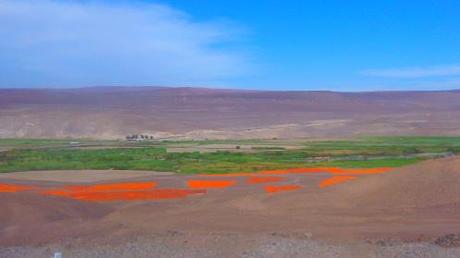
With this in mind and with Roberto (owner of our hostel) providing us with the dos and don’ts of this border crossing, we headed off to the International bus terminal in search of a collectivo that would take us over the border. There were many ‘collectivos’ (basically large, old, American cars) that were being loaded with passengers looking to make their way over the border. For around £5 you have your documents organised, your transportation sorted and you are then at least able to approach feeling moderately comfortable about this border crossing. As with any time your passport is taken from you and you are not entirely, 100% sure where it is being taken to, there is an element of concern and worry that crops up, but it is soon ushered away as your documents are returned to you with the exit card filled out for you…and you’re ready to go.
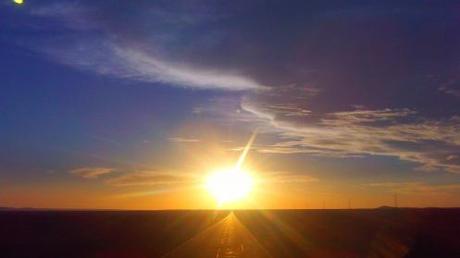
Although our taxi driver was perhaps a little, driven let’s say, at times, he was very helpful at getting us through border control and then on to Tacna where we were dropped off at the bus station. In all honesty, this border crossing was remarkably easy without any notable hassle. From Tacna, we were directed to the bus terminal we would need to buy tickets for our onward bus to Arequipa.
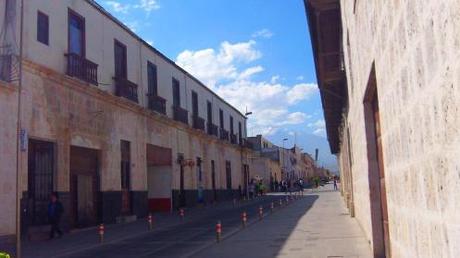
We chose, after I researched, to go with a bus company called ‘Flores’, however it wasn’t the most comfortable journey in the world and in all honesty the bus had seen better days. Who knows, perhaps we were not particularly in favour that day, but either way, we were on our way to Arequipa, a journey that was meant to take around six hours, became eight hours but here we were, in Arequipa and in a taxi (make sure you take an official taxi from the bus station, there is a problem with Taxis in Arequipa either robbing tourists or taking you to destination hotels and hostels that the get commission from). We arrived at Arequipa Backpacker’s in the early evening and after being welcomed and toured around the hostel – it really is a good hostel – we went out to grab a bite to eat and then returned to the hostel for a decent night’s sleep so that we could see what Arequipa had to offer via the gift of daylight.
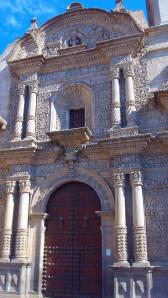
The staff at Arequipa Backpacker’s were very helpful indeed, with good knowledge of the town and also a tour booking service on-site. One of the most popular destinations outside of Arequipa is the Colca Canyon. There are various tours and treks available from two-day, one night tours to 7 day hikes of the canyon. There are also options to climb several of the volcanoes in the area including the ‘Misti’, Chachani and PichuPichu volcanoes. Perhaps a slight question mark over my timing here, but as I have to be in Lima to start a two-week Spanish course I was limited to the tours I could do in order to get back to Arequipa in time to catch my overnight bus to Lima. So, I booked myself on the two-day, one night tour of the Colca Canyon for the following day which would give me some time to explore Arequipa.
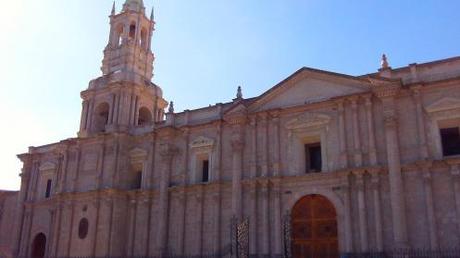
I must say, I really do like Arequipa. Before coming here and as mentioned beforehand, it has a slightly negative, only slightly, reputation with giving tourists a little bit of hassle, but that is more at the bus terminal, when you move into the main square, and again, as long as you heed advice, it is relatively safe and there is a decent presence of security there so it is safer than it once was.
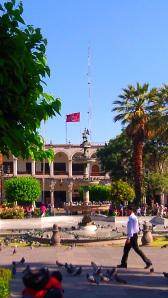
The main square; ‘Plaza del Armas’is a beautiful offering with a very regal feel about it, a grandiose presence, with large white buildings (the City is nicknamed ‘The White City’ as the buildings are made from a white volcanic rock called ‘sillar’) with a gorgeous water fountain indicating the centre of the square. It was a delightful day and a delightful walk around the square.
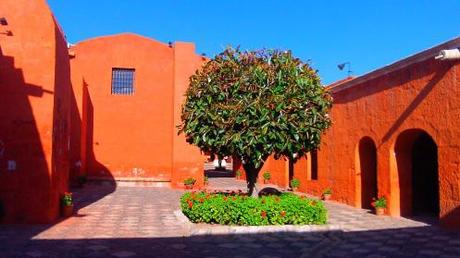
Not too far from the square is one of the most popular attractions in Arequipa; ‘Covento de Santa Catalina’ which is like a City within a City. Arguably it’s a touch on the pricey side to get in at 35 Soles but once inside you can spend a few hours getting lost in the stunningly colourful little streets and taking a walk up the main building where you are rewarded with a delightful view of the volcanoes that skirt the City.
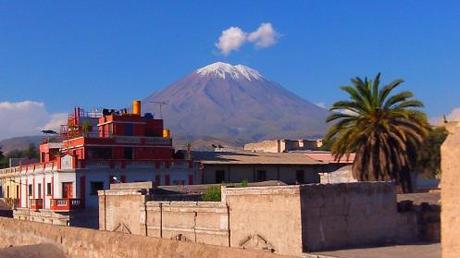
With many other churches in the area, all maintained to impeccable standards, something the City should be proud of, there is a lot of history in Arequipa and after visiting several of the many markets in the area, including the main one; ‘San Camilo’ it was, once more, back to the hostel as the night drew in, enjoying a couple of social drinks before hitting the dorm for an early start tomorrow for my Colca Canyon tour.
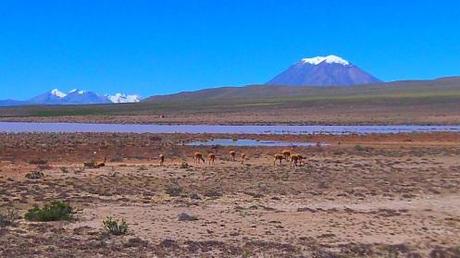
The tour operator that Arequipa Backpacker’s use is ‘Pampa Qori’ and they came to the hostel at just before 8am to pick me up and begin the excursion. I would be joining around 12 other people on the tour and we were soon heading off, out of Arequipa and to our first destination on this tour; the ‘Reserva Nacional de Aguada Blanca’ to observe vicuña, llamas and alpacas in their natural, wild environment. It wasn’t just the animal life that was impressive, but the plant life able to survive and thrive at altitude. Such plants included ‘Ichu’ and ‘Tola’.
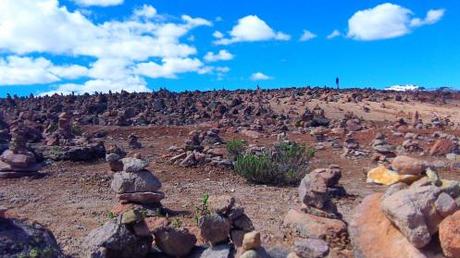
Moving on and a few hours later we stopped at ‘Patapampa’, the highest point on the trip at 4,800m. In preparation for this climb skywards, we had been advised to drink lots of coca tea and also chew lots of coca leaves as they are a natural way to help with the altitude. Personally, and whether a placebo or not, they definitely helped and the green-stained teeth were a particularly attractive look I felt!
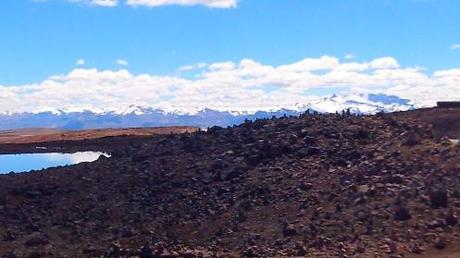
The guide was knowledgeable and again picked out unique species of plant in the area; ‘Yareta’ which is the only plant to grow above 5,000 metres. One rather eerie presence at this site was the piles of stones stacked on top of one another known as ‘apachetas’ and have special significance to the townspeople. A bit further on and we were at the volcano lookout where you get to appreciate the amazing grandeur of the ‘Ampato’, ‘Sabancaya’ and ‘Hualca hualca’ volcanoes. A truly impressive experience and a startling landscape.
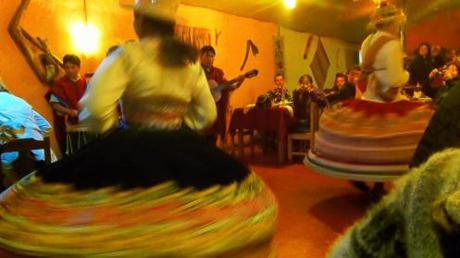
Not too much further in the bus and it was our lunch stop at the town; ‘Chivay’ which would also serve as our place of rest for the night. Before going out in the evening for some traditional Peruvian food we were taken to the natural hot springs and hot pools. In all honesty it was a lot more commercial than I was expecting and basically a leisure centre as opposed to a delightfully picturesque naturally formed rustic collection of pools! Still, it was nice to warm up and freshen up before dinner that night. It wasn’t just the traditional food we were sampling as we were also welcomed with traditional Peruvian dancers, folk dancers or ‘pena’ which actually turned out to be highly entertaining as they dragged the rather large Argentinian travelling companion out of the audience and dressed him in traditional clothing…traditional female clothing that is! After dinner and a few drinks it was back to our room and some well-deserved sleep before heading further into Colca Canyon the following morning.
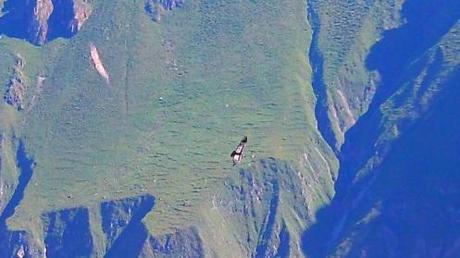
A 6am wake-up for breakfast and we were off, bread and jam in our bellies, we headed for ‘Cruz del Condor’, an area in the Colca Canyon where the rather huge condors live, scouring the landscape for morsels to feed on. Being scavengers they do not prey on other animals, merely let others animals do the work and then clean up.
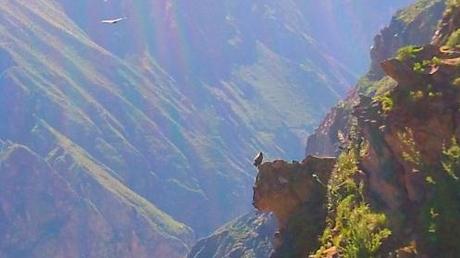
This area had been developed purely to attract the tourists. They had built a rather large look-out, in fact several look-outs along the edge of the canyon. At first it was a little disappointing, not to deny that everyone has the right to see these magnificent birds, but it all felt just a touch too forced, that was until we caught sight of our first condor – these birds are truly huge and utterly majestic! All of the ‘too touristy’ rubbish went out the window as, en-mass; we all gasped as they soared past us, truly graceful.

After an hour at the condor hang-out we were back in the bus and back to Chivay but stopping at several small villages in the canyon of Pinchollo, Maca, Achoma and Yanque where we could see various old churches, farming methods and traditional canyon way-of-life. (Well, close to traditional anyhow).
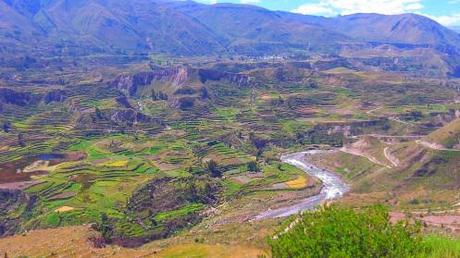
After lunch we were back on the long road to Arequipa having seen some truly magnificent views; Colca Canyon is beautiful, truly beautiful and definitely worth a visit.
I had an hour to kill before catching a rather luxurious bus, one that would take 21 hours, to get to the capital of Peru, Lima.
On a side-note; we will not be in London for the 2012 Olympics so will not be blogging about this truly grand event! However, please do check out our partner blog for updates:
